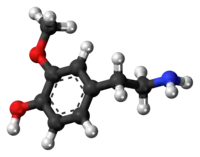3-甲氧基酪胺
3-甲氧基酪胺(3-MT),或稱3-甲氧基-4-羟基苯乙胺,是一种人体痕量胺,是神经递质多巴胺的代谢产物。[1]通过儿茶酚-O-甲基转移酶(COMT)将一個甲基引入多巴胺而形成。3-MT可进一步被单胺氧化酶(MAO)代谢形成高香草酸(HVA),然后随尿液排出人體。
| 3-甲氧基酪胺 | |
|---|---|
 | |
 | |
| 别名 | 3-甲氧基-4-羟基苯乙胺 |
| 识别 | |
| CAS号 | 554-52-9 |
| PubChem | 1669 |
| ChemSpider | 1606 |
| InChI |
|
| InChIKey | DIVQKHQLANKJQO-UHFFFAOYAB |
| MeSH | 3-methoxytyramine |
| IUPHAR配体 | 6642 |
| 性质 | |
| 化学式 | C9H13NO2 |
| 167.21 g·mol⁻¹ | |
| 若非注明,所有数据均出自标准状态(25 ℃,100 kPa)下。 | |
參見
参考文獻
- . Biomed. Pharmacother. October 2016, 83: 439–449. PMID 27424325. doi:10.1016/j.biopha.2016.07.002.Khan MZ, Nawaz W (October 2016). "The emerging roles of human trace amines and human trace amine-associated receptors (hTAARs) in central nervous system". Biomed. Pharmacother. 83: 439–449. doi:10.1016/j.biopha.2016.07.002. PMID 27424325.
- . PLOS ONE. 2010, 5 (10): e13452. Bibcode:2010PLoSO...513452S. PMC 2956650
 . PMID 20976142. doi:10.1371/journal.pone.0013452.
. PMID 20976142. doi:10.1371/journal.pone.0013452. - Broadley KJ. . Pharmacol. Ther. 2010-03, 125 (3): 363–375. PMID 19948186. doi:10.1016/j.pharmthera.2009.11.005.
- Lindemann L, Hoener MC. . Trends Pharmacol. Sci. 2005-05, 26 (5): 274–281. PMID 15860375. doi:10.1016/j.tips.2005.03.007.
- Wang X, Li J, Dong G, Yue J. . Eur. J. Pharmacol. 2014-02-05, 724: 211–218. PMID 24374199. doi:10.1016/j.ejphar.2013.12.025.
The highest level of brain CYP2D activity was found in the substantia nigra ... The in vitro and in vivo studies have shown the contribution of the alternative CYP2D-mediated dopamine synthesis to the concentration of this neurotransmitter although the classic biosynthetic route to dopamine from tyrosine is active. ... Tyramine levels are especially high in the basal ganglia and limbic system, which are thought to be related to individual behavior and emotion (Yu et al., 2003c). ... Rat CYP2D isoforms (2D2/2D4/2D18) are less efficient than human CYP2D6 for the generation of dopamine from p-tyramine. The Km values of the CYP2D isoforms are as follows: CYP2D6 (87–121 μm) ≈ CYP2D2 ≈ CYP2D18 > CYP2D4 (256 μm) for m-tyramine and CYP2D4 (433 μm) > CYP2D2 ≈ CYP2D6 > CYP2D18 (688 μm) for p-tyramine
This article is issued from Wikipedia. The text is licensed under Creative Commons - Attribution - Sharealike. Additional terms may apply for the media files.
